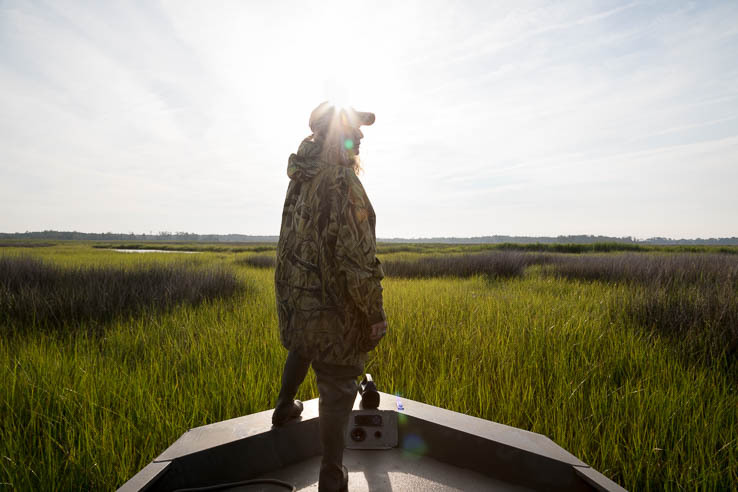Monitoring marsh birds in Monie Bay
By counting bird calls, researchers get estimate of marsh habitat health
At 5 a.m. on a muggy June morning, Chris Snow of the Maryland Department of Natural Resources and Marion Clement of the Maryland Bird Conservation Partnership load a small boat, spray their clothes with bug spray and head out into the still waters for a day full of bird surveying.
This marsh bird monitoring survey, conducted once a year at Monie Bay—a tidal salt marsh in Somerset County, Maryland—is used to measure populations of different types of birds in the area. During the survey, the pair travels to eight different spots in the marsh, playing six types of bird calls over a speaker and listening for callbacks, keeping a tally of how many are heard.
Though the survey can’t provide exact population numbers, it provides an estimated index of bird types in the area. This estimate is used to evaluate population growth and decline in the marsh. Because the birds of Monie Bay are dependent on the health of the marsh, their population numbers can be a good indicator of habitat conditions.
“If we see changes in the numbers, it prompts us to take a more in-depth look at what’s going on in the marsh,” said Snow, who is the stewardship coordinator for the Maryland portion of the Chesapeake Bay National Estuarine Research Reserve (CBNERR-MD), which encompasses Monie Bay.

In the decade that the survey has been conducted in Monie Bay, Snow has noticed a decline in certain bird calls, such as the black rail. According to Snow, problems like sea level rise, development and pollution are possible causes.
“Sea level rise is a big challenge for the lower Eastern Shore,” said Snow. “Marshes are getting inundated more frequently, and they’re getting higher high tides, making it more difficult for birds to nest.”
Most of the birds in Monie Bay build their nests just above high tide lines, making it easy for them to flood. Standing water in the marsh can also cause vegetation to die, meaning a loss of habitat for the birds.
CBNERR-MD conducts this same survey at each of the reserve’s three component areas: Monie Bay, Jug Bay and Otter Point Creek. Researchers then compare that data in hopes of gaining regional and statewide perspectives of populations and habitat conditions. According to the Monie Bay survey, population numbers of most bird species, such as the clapper rail and least bittern, have remained the same.
“Most of these numbers are a good sign,” said Snow. “It’s a good indicator that the marsh is able to provide them what they need.”
To view more photographs, visit the Chesapeake Bay Program Flickr page.

Comments
They do actually sample several time during the nesting season and recently switched up their sampling protocols. Until last year, they used the national marsh bird protocols, which suggested 4-6 sampling dates. Currently they use the SHARPS protocols which call for three sampling dates. They switched to be more in line with other mid-Atlantic sites. I have included links to both:
National Marsh Bird Protocol
https://www.cals.arizona.edu/research/azfwru/NationalMarshBird/downloads/North American Marsh Bird Survey Protocol May 2009.pdf
Saltmarsh Habitat & Avian Research Program
https://www.tidalmarshbirds.org/?page_id=131
Awesome work !! Wondering if one sample day per year will provide an accurate representation of any trends?
Thank you!
Your comment has been received. Before it can be published, the comment will be reviewed by our team to ensure it adheres with our rules of engagement.
Back to recent stories